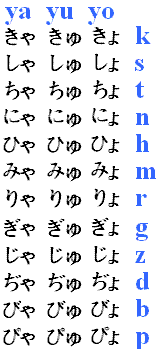Japanese Basics
| |
Hiragana (平仮名) - Click each row to listen | |
 |  |
Katakana (片仮名) - Click each row to listen | |
 | |
Kanji (漢字)Kanji (漢字) are Chinese characters that are used in the modern Japanese logographic writing system. Click to listen to the following examples:英語 えいご (English) | 中国語 ちゅうごくご (Chinese) | アメリカ合衆国 あめりかがっしゅうこく (The United States of America (USA)) =米国(べいこく) | 月曜日 げつようび (Monday) | 火曜日 かようび (Tuesday) | 水曜日 すいようび (Wednesday) | 木曜日 もくようび (Thursday) | 金曜日 きんようび (Friday) | 土曜日 どようび (Saturday) | 日曜日 にちようび (Sunday) | 音楽 おんがく (music) | 黄金時代 おうごんじだい (the golden age) | | |
Japanese GrammarJapanese is very flexible, but generally has a "Subject-Object-Verb" structure. The grammatical functions of the words are usually marked by particles (postpositions). For example:私はソーセージを食べる (I eat sausage) ソーセージを食べない (I do not eat sausage) [Note: From the context, it's clear it's about me, so the subject (私) can be omitted] Some useful particles:
| |
- writing [´raitiŋ]
 n.书写;写作;书法 (初中英语单词)
n.书写;写作;书法 (初中英语单词) - learning [´lə:niŋ]
 n.学习;学问;知识 (初中英语单词)
n.学习;学问;知识 (初中英语单词) - system [´sistəm]
 n.系统,体系,制度 (初中英语单词)
n.系统,体系,制度 (初中英语单词) - structure [´strʌktʃə]
 n.结构,构造;组织 (初中英语单词)
n.结构,构造;组织 (初中英语单词) - grammatical [grə´mætikəl]
 a.语法上的 (初中英语单词)
a.语法上的 (初中英语单词) - sentence [´sentəns]
 n.判决 vt.宣判;处刑 (初中英语单词)
n.判决 vt.宣判;处刑 (初中英语单词) - elephant [´elifənt]
 n.象 (初中英语单词)
n.象 (初中英语单词) - flexible [´fleksəbəl]
 a.灵活的,柔韧的 (英语四级单词)
a.灵活的,柔韧的 (英语四级单词)


 京公网安备 11011202003401号
京公网安备 11011202003401号
